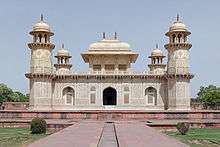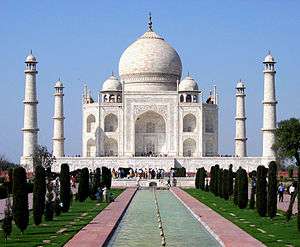Tomb of I'timād-ud-Daulah

Tomb of I'timād-ud-Daulah (Urdu: اعتماد الدولہ کا مقبرہ, I'timād-ud-Daulah kā Maqbara) is a Mughal mausoleum in the city of Agra in the Indian state of Uttar Pradesh. Often described as a "jewel box", sometimes called the "Baby Tāj", the tomb of I'timād-ud-Daulah is often regarded as a draft of the Tāj Mahal.
Along with the main building, the structure consists of numerous outbuildings and gardens. The tomb, built between 1622 and 1628 represents a transition between the first phase of monumental Mughal architecture – primarily built from red sandstone with marble decorations, as in Humayun's Tomb in Delhi and Akbar's tomb in Sikandra – to its second phase, based on white marble and pietra dura inlay, most elegantly realized in the Tāj Mahal.
The mausoleum was commissioned by Nūr Jahān, the wife of Jahangir, for her father Mirzā Ghiyās Beg, originally a Persian Amir in exile,[1] who had been given the title of I'timād-ud-Daulah (pillar of the state). Mirzā Ghiyās Beg was also the grandfather of Mumtāz Mahāl (originally named Arjūmand Bāno, daughter of Asaf Khān), the wife of the emperor Shāh Jahān, responsible for the construction of the Tāj Mahal. Nur Jehan was also responsible for the construction of the Tomb of Jehangir at Lahore.
Tomb

Located on the right bank of the Yamuna River, the mausoleum is set in a large cruciform garden criss-crossed by water courses and walkways. The mausoleum itself covers about twenty-three meters square, and is built on a base about fifty meters square and about one meter high. On each corner are hexagonal towers, about thirteen meters tall.
The walls are made up from white marble from Rajasthan encrusted with semi-precious stone decorations – cornelian, jasper, lapis lazuli, onyx, and topaz formed into images of cypress trees and wine bottles, or more elaborate decorations like cut fruit or vases containing bouquets. Light penetrates to the interior through delicate jālī screens of intricately carved white marble. The interior decoration is considered by many to have inspired that of the Taj Mahal, which was built by her stepson, Mughal emperor Shah Jahan.
Many of Nūr Jahān's relatives are interred in the mausoleum. The only asymmetrical element of the entire complex is that the cenotaphs of her father and mother have been set side-by-side, a formation replicated in the Tāj Mahal.
Gallery
 General view from the river
General view from the river Entrance gate, outside view
Entrance gate, outside view- Entrance gate, inside view
- Mausoleum seen from the gate
 Mausoleum from the west
Mausoleum from the west- Corner view
 Domed top of minaret
Domed top of minaret Cornice and supports, detail
Cornice and supports, detail Exterior wall, detail with niche
Exterior wall, detail with niche Exterior wall, detail with niche
Exterior wall, detail with niche Geometrically patterned panel with 10-point stars
Geometrically patterned panel with 10-point stars Jali pierced stone screen
Jali pierced stone screen Pietra dura vases in marble wall with geometric floral border
Pietra dura vases in marble wall with geometric floral border Interior decorated with vases, vegetal and geometric patterns
Interior decorated with vases, vegetal and geometric patterns Pietra dura on mausoleum interior wall
Pietra dura on mausoleum interior wall- Pietra dura on mausoleum interior wall
References
- ↑ کتاب سفرنامه هند ص55–58 در سال ۱۳۵۰ خورشیدی. نوشته محمدرضا خانی. به فارسی.
External links
| Wikimedia Commons has media related to Itmad-Ud-Daulah's Tomb. |
- Itmad ud Daulah on YouTube
- Pictures of Etimad-ud-Daulah's Tomb Pictures of Itmad-Ud-Daulah's Tomb from a backpackers trip around India
- The Tomb of Etimad-ud-Daula
Coordinates: 27°11′33″N 78°01′55″E / 27.19250°N 78.03194°E
